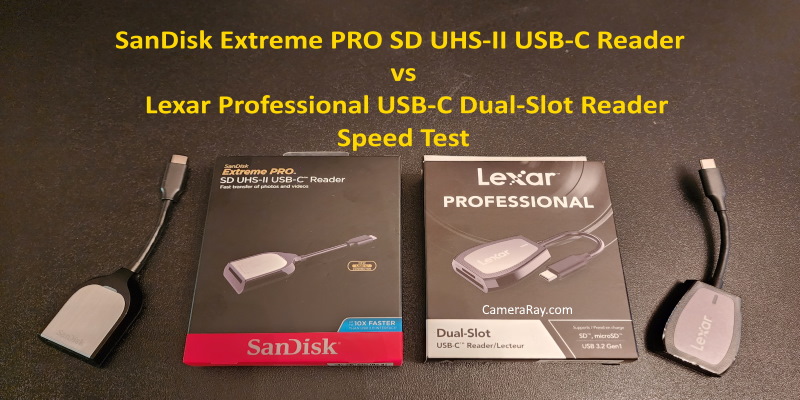
SanDisk Extreme PRO SD UHS-II USB-C Reader vs Lexar Professional USB-C Dual-Slot Reader Speed Test.
This is a transfer speed test between the top selling USB-C UHS-II card readers. In the video I will give you file transfer time and build quality between the SanDisk Extreme PRO and Lexar Professional USB-C card readers.
In today’s fast-paced world, photographers, videographers, and content creators need equipment that’s both high-quality and efficient. One aspect often overlooked but of paramount importance is the speed and efficiency with which data is transferred from memory cards to computers. Enter the world of card readers: devices designed to swiftly and securely access the content of memory cards. Two leading brands in this market are SanDisk and Lexar, and today we will delve deep into comparing their flagship USB-C readers: the SanDisk Extreme PRO SD UHS-II USB-C Reader and the Lexar Professional USB-C Dual-Slot Reader.
1. Design and Build Quality:
SanDisk Extreme PRO: SanDisk’s offering comes with a sleek and straightforward design, made primarily of high-quality plastics with a metallic finish. It’s compact and lightweight, making it ideal for on-the-go users. The build is durable and feels premium, a testament to SanDisk’s commitment to quality.
Lexar Professional Dual-Slot: Lexar’s reader boasts a more utilitarian design, focusing on function with its dual-slot feature. It can accommodate both SD and microSD cards simultaneously, a significant advantage for users who work with different card formats. The build quality, much like its competitor, is top-notch, with robust materials ensuring longevity.
2. Speed and Performance:
SanDisk Extreme PRO: Designed for UHS-II SD cards, this reader can handle high-speed data transfer with ease. It leverages the USB-C interface’s full potential, ensuring that content creators experience minimal lag while transferring heavy files like 4K videos or RAW photos. It’s optimized for SanDisk’s Extreme PRO SD cards but is also backward compatible with older SD card versions.
Lexar Professional Dual-Slot: This card reader is not just versatile in design but also in performance. It supports both UHS-II SD and microSD cards, giving it an edge in terms of flexibility. When it comes to speed, Lexar promises efficient high-speed transfers that rival SanDisk’s offering. Its dual-slot feature allows for simultaneous data transfer, saving precious time for professionals.
Buy the SanDisk Extreme PRO SD UHS-II USB-C Reader HERE
Lexar Professional USB-C UHS-II Dual-Slot Reader HERE
3. Connectivity:
Both devices utilize the USB-C interface, marking their commitment to modern standards and ensuring compatibility with the latest devices. The USB-C connection provides faster data transfer speeds and is rapidly becoming the standard for most high-end devices, from laptops to cameras.
4. Compatibility and Versatility:
SanDisk Extreme PRO: This reader is designed specifically for SD cards, particularly the UHS-II variant. While it does its job excellently for this card type, it lacks the versatility of handling multiple card formats.
Lexar Professional Dual-Slot: Lexar’s offering shines in this department. Its dual-slot design allows it to read both SD and microSD cards, making it the go-to choice for those who regularly work with different devices and card formats.
5. Price and Value for Money:
Both devices are priced in the premium segment, reflecting their quality and brand reputation. While SanDisk’s reader is slightly more affordable, Lexar offers the added value of dual-card compatibility, which might justify the additional cost for many users.
6. Brand Reputation and Reliability:
SanDisk and Lexar are titans in the memory storage industry. They have built their reputations over years of delivering reliable and high-quality products. Both card readers are backed by their respective brand’s warranty and customer support, ensuring peace of mind for the user.
Conclusion:
Choosing between the SanDisk Extreme PRO SD UHS-II USB-C Reader and the Lexar Professional USB-C Dual-Slot Reader boils down to individual needs. For those seeking a straightforward, high-speed SD card reader with a sleek design, SanDisk’s offering might be the perfect fit. On the other hand, professionals requiring versatility in card formats and simultaneous data transfer might find Lexar’s dual-slot reader more apt.
Regardless of the choice, both devices stand as testimony to the brands’ commitment to quality and performance, ensuring that users will not be disappointed. As the tech landscape continues to evolve, and as data transfer speeds become ever more crucial, investing in a reliable card reader is more essential than ever. Whether you lean towards SanDisk or Lexar, both are competent allies in the relentless pursuit of content creation.
I bought the same Lexar Professional Dual-Slot card reader. Mine has the same problem with grinding the cards when you insert them. If i had to do it again i would buy the SanDisk Extreme PRO reader instead. Thanks for the review.